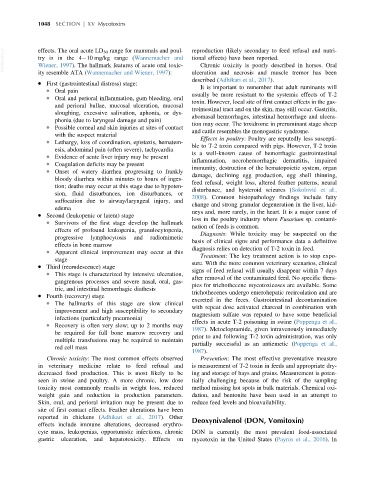Page 1116 - Veterinary Toxicology, Basic and Clinical Principles, 3rd Edition
P. 1116
1048 SECTION | XV Mycotoxins
VetBooks.ir effects. The oral acute LD 50 range for mammals and poul- reproduction (likely secondary to feed refusal and nutri-
tional effects) have been reported.
try is in the 4 10 mg/kg range (Wannemacher and
Chronic toxicity is poorly described in horses. Oral
Wiener, 1997). The hallmark features of acute oral toxic-
ity resemble ATA (Wannemacher and Wiener, 1997): ulceration and necrosis and muscle tremor has been
described (Adhikari et al., 2017).
First (gastrointestinal distress) stage:
It is important to remember that adult ruminants will
Oral pain
usually be more resistant to the systemic effects of T-2
Oral and perioral inflammation, gum bleeding, oral
toxin. However, local site of first contact effects in the gas-
and perioral bullae, mucosal ulceration, mucosal
trointestinal tract and on the skin, may still occur. Gastritis,
sloughing, excessive salivation, aphonia, or dys-
abomasal hemorrhages, intestinal hemorrhage and ulcera-
phonia (due to laryngeal damage and pain)
tion may occur. The toxidrome in preruminant stage sheep
Possible corneal and skin injuries at sites of contact
and cattle resembles the monogastric syndrome.
with the suspect material
Effects in poultry: Poultry are reputedly less suscepti-
Lethargy, loss of coordination, epistaxis, hematem-
ble to T-2 toxin compared with pigs. However, T-2 toxin
esis, abdominal pain (often severe), tachycardia
is a well-known cause of hemorrhagic gastrointestinal
Evidence of acute liver injury may be present
inflammation, necrohemorrhagic dermatitis, impaired
Coagulation deficits may be present
immunity, destruction of the hematopoietic system, organ
Onset of watery diarrhea progressing to frankly
damage, declining egg production, egg shell thinning,
bloody diarrhea within minutes to hours of inges-
feed refusal, weight loss, altered feather patterns, neural
tion; deaths may occur at this stage due to hypoten-
disturbance, and hysteroid seizures (Sokolovi´ c et al.,
sion, fluid disturbances, ion disturbances, or
2008). Common histopathology findings include fatty
suffocation due to airway/laryngeal injury, and
change and strong granular degeneration in the liver, kid-
edema
neys and, more rarely, in the heart. It is a major cause of
Second (leukopenic or latent) stage
loss in the poultry industry where Fusarium sp. contami-
Survivors of the first stage develop the hallmark
nation of feeds is common.
effects of profound leukopenia, granulocytopenia,
Diagnosis: While toxicity may be suspected on the
progressive lymphocytosis and radiomimetic
basis of clinical signs and performance data a definitive
effects in bone marrow
diagnosis relies on detection of T-2 toxin in feed.
Apparent clinical improvement may occur at this
Treatment: The key treatment action is to stop expo-
stage
sure. With the more common veterinary scenarios, clinical
Third (recrudescence) stage
signs of feed refusal will usually disappear within 7 days
This stage is characterized by intensive ulceration,
after removal of the contaminated feed. No specific thera-
gangrenous processes and severe nasal, oral, gas-
pies for trichothecene mycotoxicoses are available. Some
tric, and intestinal hemorrhagic diathesis
trichothecenes undergo enterohepatic recirculation and are
Fourth (recovery) stage
excreted in the feces. Gastrointestinal decontamination
The hallmarks of this stage are slow clinical
with repeat dose activated charcoal in combination with
improvement and high susceptibility to secondary
magnesium sulfate was reputed to have some beneficial
infections (particularly pneumonia)
effects in acute T-2 poisoning in swine (Poppenga et al.,
Recovery is often very slow; up to 2 months may
1987). Metoclopramide, given intravenously immediately
be required for full bone marrow recovery and
prior to and following T-2 toxin administration, was only
multiple transfusions may be required to maintain
partially successful as an antiemetic (Poppenga et al.,
red cell mass
1987).
Chronic toxicity: The most common effects observed Prevention: The most effective preventative measure
in veterinary medicine relate to feed refusal and is measurement of T-2 toxin in feeds and appropriate dry-
decreased food production. This is most likely to be ing and storage of hays and grains. Measurement is poten-
seen in swine and poultry. A more chronic, low dose tially challenging because of the risk of the sampling
toxicity most commonly results in weight loss, reduced method missing hot spots in bulk materials. Chemical oxi-
weight gain and reduction in production parameters. dation, and bentonite have been used in an attempt to
Skin, oral, and perioral irritation may be present due to reduce feed levels and bioavailability.
site of first contact effects. Feather alterations have been
reported in chickens (Adhikari et al., 2017). Other
Deoxynivalenol (DON, Vomitoxin)
effects include immune alterations, decreased erythro-
cyte mass, leukopenias, opportunistic infections, chronic DON is currently the most prevalent food-associated
gastric ulceration, and hepatotoxicity. Effects on mycotoxin in the United States (Payros et al., 2016). In

